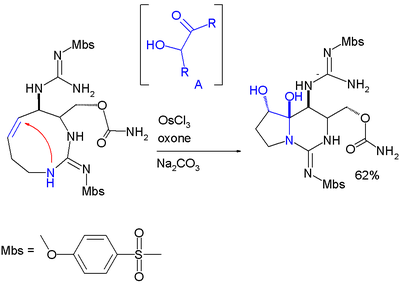- Hemiaminal
-
A hemiaminal is a functional group or type of chemical compound that has a hydroxyl group and an amine attached to the same carbon atom: -C(OH)(NR2)-. R can be hydrogen or an alkyl group. Hemiaminals are intermediates in imine formation from an amine and a carbonyl by alkylimino-de-oxo-bisubstitution.
An example is of an hemiaminal is that obtained from reaction of secondary amine carbazole and formaldehyde [1][2]
Those generated from primary amines are unstable to the extent that they have never been isolated and very rarely been observed directly. In a 2007 study a hemiaminal substructure trapped in the cavity of a host-guest complex was studied with a chemical half-life of 30 minutes. Because both amine and carbonyl group are isolated in a cavity, hemiaminal formation is favored due to a high forward reaction rate comparable to a intramolecular reaction and also due to restricted access of external base (another amine) to the same cavity which would favor elimination of water to the imine.[3]
Hemiaminal formation is a key step in an asymmetric total synthesis of saxitoxin [4]:
In this reaction step the alkene group is first oxidized to an intermediate acyloin by action of osmium(III) chloride, oxone (sacrificial catalyst) and sodium carbonate (base).
See also
References
- ^ Carbazol-9-yl-methanol Milata Viktora, Kada Rudolfa, Lokaj J¨¢nb Molbank 2004, M354 open access publication [1]
- ^ Reaction in methanol in reflux with potassium carbonate. Acid catalysis turns the hemiaminal to the aminal N,N´-biscarbazol-9-yl-methane.
- ^ Stabilization of Labile Carbonyl Addition Intermediates by a Synthetic Receptor Tetsuo Iwasawa, Richard J. Hooley, Julius Rebek Jr. Science 317, 493 (2007) doi:10.1126/science.1143272
- ^ (+)-Saxitoxin: A First and Second Generation Stereoselective Synthesis James J. Fleming, Matthew D. McReynolds, and J. Du Bois J. Am. Chem. Soc., 129 (32), 9964 -9975, 2007. doi:10.1021/ja071501o
Categories:- Functional groups
Wikimedia Foundation. 2010.



